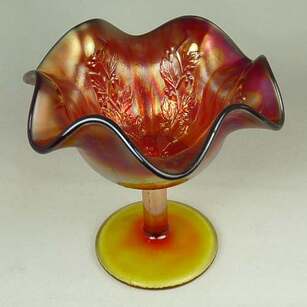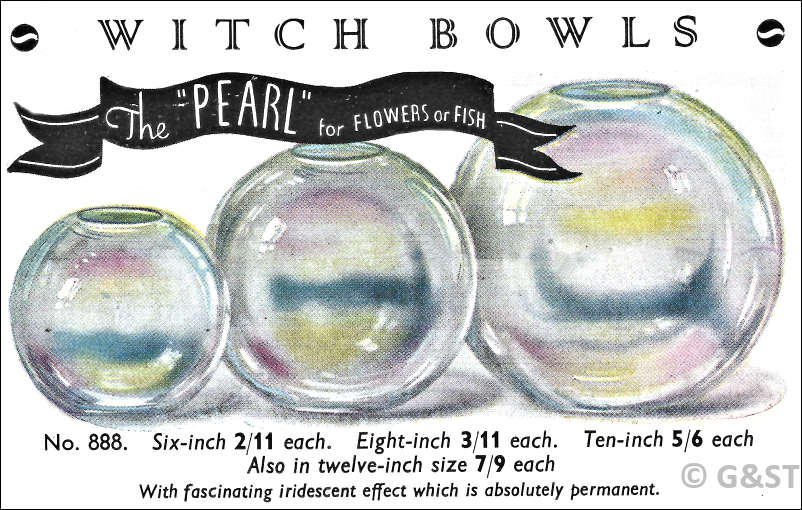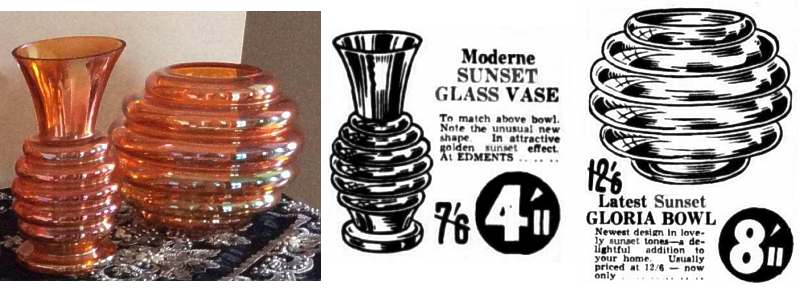NetworK ezine Issue 55. December 2019
Totally Devoted to Carnival Glass
Welcome to the 55th. edition of our free Carnival Glass ezine, NetworK, which is going out to a record number of Carnival enthusiasts all around the world.
|
Carnival Glass really is an astonishing subject, isn’t it? It spans so many years, was made in so many countries, and has so many forms, shapes, colours and patterns, that there is always something new and interesting to learn about it. We hope you enjoy the journey of discovery in this issue.
The Christmas gift ad on the right appeared in a 1928 Australian newspaper (courtesy National Library of Australia). Do you recognise the vase? It’s Brockwitz Footed Prisms. On the far right, we show a blue Carnival example, which is not too easy to find but is just the right shape for a Christmas stocking! Fenton in the UK
Shown below - a splendid and very decorative ad offering “Iridescent Art Ware”. It’s stylish and has a classy look. You’ll recognise that the glass features familiar Fenton patterns – Orange Tree, Vintage and Panther. The vase may not be quite as familiar – it’s known as Fenton Flute. |
The business that placed this ad in the Pottery Gazette was the National Glass Co Ltd., which was a UK sales agency established by Charles Pratt. The UK glass trade press described Pratt as being “mainly responsible for introducing to the English market the high quality American pressed table ware”. To be fair, another agent, Markt & Co. (London) Ltd. - see NetworK 53 - had also promoted American glass, including Carnival, a decade or more earlier, too. The items in this amazing 1923 ad are, clockwise from top left: Fenton Flowers aka Orange Tree rose bowl (note it is described in the ad as a “nut bowl”); Vintage fern dish, Panther footed berry (“flared dish”), Fenton Flute vase and what appears to be an Orange Tree ruffled bowl. Although the text of the ad indicates that the iridescent items were available in “golden, green, violet and royal blue” (marigold, green, amethyst/purple and blue) most of the pieces featured in this ad have also been found in the UK in the rare colours of red, and celeste blue. These were later (1920s) Carnival colours from Fenton, and the 1923 date of the ad underscores this timeline. |
Left to right, above: Orange Tree (aka Fenton Flowers) rosebowl, Vintage fernery and Panther footed sauce.
Below: Orange Tree ruffled bowl, Flute vase and a Holly comport.
Vintage, Panther and Orange Tree bowl pictures are courtesy of Seeck Auctions.
Below: Orange Tree ruffled bowl, Flute vase and a Holly comport.
Vintage, Panther and Orange Tree bowl pictures are courtesy of Seeck Auctions.
All these are Fenton pieces in red Carnival, with the exception of the Holly comport which is red with an amberina stem/foot.
We deliberately chose to show all the examples of these pieces in red, as we wanted to underline the emergence of (pressed) red as a Carnival Glass colour in the early 1920s. Pressed red glass was was not made on a commercially viable basis before that time.
Why? One of the reasons was the lack of availability of selenium (which helped to give it the red colour) until around 1919. In the early 1920s, Fenton worked hard to produce a good red glass, that would work for mass-production. It took skill to get the colour just right, which is why there are colour variations such as amberina (and reverse amberina). As can be seen in the Fenton Holly comport, the top is a good, deep red, whereas the stem and foot are amberina (where the red colour didn't "strike" as intended).
You can read all about the making of red Carnival, and learn some of its secrets, in our article, here: “There’s no Gold in my glass”.
And here are two more links to further reading:
- Charles Pratt and Celeste Blue
- Fenton's Flute
We deliberately chose to show all the examples of these pieces in red, as we wanted to underline the emergence of (pressed) red as a Carnival Glass colour in the early 1920s. Pressed red glass was was not made on a commercially viable basis before that time.
Why? One of the reasons was the lack of availability of selenium (which helped to give it the red colour) until around 1919. In the early 1920s, Fenton worked hard to produce a good red glass, that would work for mass-production. It took skill to get the colour just right, which is why there are colour variations such as amberina (and reverse amberina). As can be seen in the Fenton Holly comport, the top is a good, deep red, whereas the stem and foot are amberina (where the red colour didn't "strike" as intended).
You can read all about the making of red Carnival, and learn some of its secrets, in our article, here: “There’s no Gold in my glass”.
And here are two more links to further reading:
- Charles Pratt and Celeste Blue
- Fenton's Flute
Witch Bowls
What exactly are witch bowls?
They were a Jazz Age craze used in home decoration – typically of glass, moulded (or blown) in a round shape, often with horizontal ribs (like the Melon Rib style). Witch bowls began to gain favour in the 1920s and were all the rage in the 1930s. And you could get them in iridescent glass! The Albany (NY) Times in 1933 wrote “there is something so fascinating about gleaming, iridescent glass” … and continued to extol the virtues of iridescent witch bowls of which it observed “you are almost certain to fall under their spell”. Witch bowls were similar to rose bowls in shape, and could be used for flowers or even as fish bowls. The reflective magic of glass, coupled with the fascinating effects of iridescence, was often enhanced by placing mirrors behind or underneath the witch bowls to make them even more beguiling and bewitching.
The witch bowls in the illustrations shown below, right, were made in Europe, possibly (but not certainly) by Inwald. The extract is from a booklet issued in 1934 by the London agent, Clayton Mayers, who handled almost all Inwald’s British business, especially the Jacobean line. The “Pearl” line witch bowls are all iridised and appear to have been blown. The “Jasmin” line witch bowls also included iridised examples – and these would have been blown into moulds to achieve that moulded roll or rib shape. The similarity between the shape of the European “Jasmin” witch bowls and Carnival Melon Rib items made in Australia by Crown Crystal, is striking.
What exactly are witch bowls?
They were a Jazz Age craze used in home decoration – typically of glass, moulded (or blown) in a round shape, often with horizontal ribs (like the Melon Rib style). Witch bowls began to gain favour in the 1920s and were all the rage in the 1930s. And you could get them in iridescent glass! The Albany (NY) Times in 1933 wrote “there is something so fascinating about gleaming, iridescent glass” … and continued to extol the virtues of iridescent witch bowls of which it observed “you are almost certain to fall under their spell”. Witch bowls were similar to rose bowls in shape, and could be used for flowers or even as fish bowls. The reflective magic of glass, coupled with the fascinating effects of iridescence, was often enhanced by placing mirrors behind or underneath the witch bowls to make them even more beguiling and bewitching.
The witch bowls in the illustrations shown below, right, were made in Europe, possibly (but not certainly) by Inwald. The extract is from a booklet issued in 1934 by the London agent, Clayton Mayers, who handled almost all Inwald’s British business, especially the Jacobean line. The “Pearl” line witch bowls are all iridised and appear to have been blown. The “Jasmin” line witch bowls also included iridised examples – and these would have been blown into moulds to achieve that moulded roll or rib shape. The similarity between the shape of the European “Jasmin” witch bowls and Carnival Melon Rib items made in Australia by Crown Crystal, is striking.
|
Let’s see why … From Europe to Australia In 1934 (the same date as the ads for the European witch bowls on the right) a group of five skilled glassmakers left Czechoslovakia in Europe on their way to Australia. It was reported widely in the Australian press at the time (below). The men, who were described elsewhere as glassblowers / designers, were there to “train young Australians at the Sydney factory (Crown Crystal) in the art of glassware making by hand” which was to include “luxury glass”. Extract from Perth News, 1934. Courtesy National Library of Australia.
|
Above: extracts from “Table Glassware” booklet 1934.
|
The Czech glassmakers had been “engaged by the owner of the Sydney factory (Crown Crystal) when he made a trip abroad”. Four years later, in 1938, the fruits of the Czech glass makers tuition and the labours of their young Australian students paid off. Crown Crystal launched their own line of blown (Melon Rib style) decorative glassware.
Thanks to Gio Sabino Lopez for this splendid photo featuring four Melon Rib vases from Crown Crystal.
Top row: smoke Carnival (left) and rosalin pink not iridised.
Bottom row: uranium green/Vaseline not iridised (left - the first reported in this colour) and marigold Carnival.
Top row: smoke Carnival (left) and rosalin pink not iridised.
Bottom row: uranium green/Vaseline not iridised (left - the first reported in this colour) and marigold Carnival.
Our ground-breaking research some years ago (2013) uncovered the proof that Crown Crystal were making iridised Melon Rib vases from 1938.
|
We also uncovered a newspaper report that said the glass had been designed by a “Rumanian artist brought to Australia by the Crown Company” (although more recently uncovered information suggests that the “artist” was in fact from Austria, possibly Vienna, which was where Inwald’s head office was located.
Now we have the timeline and the full story! Czech glass makers took their skills, ideas and designs to Crown Crystal in Australia in 1934, and subsequently taught, inspired and helped the Australian glass makers to produce their own range of beautiful, blown (Melon Rib style) glassware that was launched in 1938. |
Above: a 1941 newspaper ad in the Hobart Mercury (on the right) showed a Melon Rib style bowl and vase. The description, “sunset”, indicates they were made in marigold iridescence. On the left are those exact items, shown here courtesy “Auntie Trace”.
|
Read more about Crown Crystal and their Melon Rib pattern here: Read All About It - The Melon Rib Proof!
|
|
To add to the general air of intrigue about this pattern, the original moulds for the pitcher and tumbler were sold and lay unused until 1975, when they were once again put into production to make Contemporary Carnival reproductions. There is a further twist to the tale. Dorothy Taylor commissioned the Botson Machine and Mould Company of Cambridge, Ohio to make miniature versions of this pattern for her "Encore" club. Initially there was a miniature water set, and then subsequently extended to include a miniature table set and a miniature cup/saucer/plate set. All these items were very sought-after by club members, and they had limited production runs. The full story of this fascinating pattern is here: “God and Home - The Story Behind the Glass”. |
Above: a reproduction God and Home water set in purple, made for
L. G. Wright by Westmoreland. Courtesy Seeck Auctions. |
Privacy and the use of your information: we only use your name and email address to send you your FREE Carnival Glass NetworK ezine. We will not share your name or email address with anyone else, or use it for any other purpose. You can change your mind about receiving your NetworK ezine at any time by clicking the unsubscribe link at the foot of every issue, or by emailing us at [email protected]
Join us on Facebook
We invite you and your friends to join us all on NetworK's fast growing and very active Facebook Group (link is below), and if you have missed any of the previous issues of NetworK and NetworK Specials, they are all here: Back Issues.
We invite you and your friends to join us all on NetworK's fast growing and very active Facebook Group (link is below), and if you have missed any of the previous issues of NetworK and NetworK Specials, they are all here: Back Issues.


















